|
After the Fall of the Hammer:
Frankenstein films from the early 1970s to the 1990s (2)
Flesh
for Frankenstein (1974)
Perhaps one of the
most controversial Frankenstein movies from the 1970s
is Paul Morrissey's camp classic Flesh for Frankenstein aka Andy
Warhol's Frankenstein, which actually is not nearly as bad as its
reputation, but twice as funny.
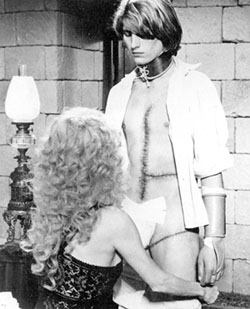
Deviant sexuality: The Monster (Srdjan
Zelenovic) and
Frankenstein's wife in Flesh for Frankenstein |
Baron Frankenstein, who has two
children with his sister Katrin, spends most of his time in his
laboratory. There he has already created a female human, for which he now
needs a male companion. Frankenstein's aim is to mate his two creations and to
create a whole new race of perfect human beings who will only obey
to his bidding. The only thing he still needs to complete his work
is a head for his male. To make sure his creations will mate he
intends to take the head from a man possessing an exceptionally
strong sexual urge, a man who "strongly craves women". One
night Frankenstein is convinced that he has found the ideal
"Serbian male" with the "perfect nasum" in a
peasant he spots at a bordello with two hookers. "Two girls! One man!...he must
be very powerful!", the Baron exclaims to his assistant Otto
and they set out to get him. What Frankenstein does not know is that
his victim is about to become a monk and actually has no interest in sex at
all. They kill the man, cut off his head and attach it to the male
Monster. Unexpectedly, the male refuses to mate with the female
Monster and Frankenstein suspects that someone might have meddled
with his work.
|
Meanwhile Frankenstein's
sister/wife Katrin recruits the stableboy Nicholas as her personal love
toy and servant. However, Nicholas becomes suspicious when he meets
Frankenstein's creation at dinner, recognizing in him his murdered friend.
He sneaks into the laboratory where he is caught by Frankenstein and Otto.
Later Frankenstein's wife enters the lab and expresses her sexual
interest in the male Monster. In hope to stimulate the Monster's sexual urge,
Frankenstein agrees to let his sister have sex with his creation.
Unfortunately, the Monster accidentally breaks Katrin's spine while they
are having sex.
In the meantime, Otto, fed up with being just the Baron's assistant, tries
his hands on the female creation, but accidentally rips open her stomach
spilling her guts over the floor. Frankenstein returns to the laboratory,
where he finds his female dead. Enraged, he strangles Otto. Soon the male
Monster returns, refuses to obey his creator, chases him through the lab and
finally impales him on a pole. Realizing that he would be better off dead,
the miserable Monster rips out his own guts and dies, despite efforts by
Nicholas to convince him to escape together.
The film ends with Frankenstein's two children getting scalpels ready
instead of releasing Nicholas from the laboratory.
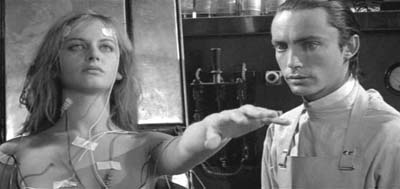
The female Monster's first movements
Filmed in 1973 in Italy, this is as far from Mary Shelley's novel as it
can get. Apart from the name Frankenstein and the central idea of creating
a monster from dead body parts, Flesh for Frankenstein contains no
other elements from the novel. Director and writer Paul Morrissey wanted to make
an absurd, ridiculous and outrageous film - and surely
succeeded. Flesh for Frankenstein (aka Andy Warhol's Frankenstein due to
Morrissey's former collaborations with Warhol), which was originally
filmed in 3D to make it "more fantastic, more absurd, more
comical" (Morrissey), is a strange movie, that people either seem to
love or hate. Of course the film can only be enjoyed if it is seen as a
comedy and parody on other Frankenstein films rather than a horror film on
its own. Morrissey achieves this by turning his Frankenstein version into
a hilarious mixture of scenes involving soft porn elements, necrophilia, incest and
over-the-top gore and splatter. The screenplay is downright ridiculous, stuffed with
lines that will make viewers burst out in laughter. All the cast members
speak in an exaggerated, staged manner and utter their non-sensical lines
with seriousness usually only found in classic theater. Actually, most of the
absurd, tongue-in-cheek dialogue was written by Morrissey in his car when
he was on its way to the Cinecitta Studios - unlike the mostly improvised
dialogue in his previous films.
However, the film has a lot more to offer for those who are willing to
accept that Morrissey was not only a trash filmmaker, but actually
conveyed some meaning hidden under a layer of naked and dismembered
bodies. The
most interesting aspect of Flesh for Frankenstein is obviously the
dysfunctional, perverse Frankenstein family, that keeps walking towards their inevitable
doom.
Baron Frankenstein is portrayed by genre favourite Udo Kier with
trade-mark German accent. He is married to his sister in an incestuous
relationship that has spawned two children. Obviously, the Baron is
not very much interested in his wife, with whom he keeps quarrelling at
the dinner table about matters such as their parents - "Why must you
always pick on father?" - or the education of their children. His
true obsession is his work and his desire to create an entirely new race
responding only to his bidding - a desire, that clearly sets Kier's
Frankenstein apart from Mary Shelley's original concept. Kier's
Frankenstein shows more interest in his creations - his
"zombies" - than in the people surrounding him. Morrissey takes
this to an extreme, when Frankenstein engages in an act of necrophilia
with his female Monster after opening her stomach and pulling out her
intestines, moaning in pleasure. He concludes this act of perverted
sexuality by explaining to his assistant Otto, " To know death, Otto,
you have to fuck life in the gall-bladder!" The most memorable line
(and indeed one that does not make too much sense) of the whole movie is
actually an allusion to a line uttered by Marlon Brando in "The Last
Tango in Paris".
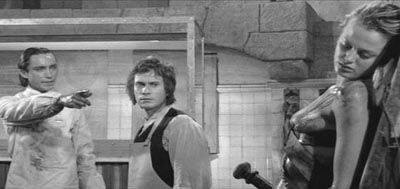
"To know death, Otto..." - Frankenstein explains the secrets of
life, death and love to Otto (Arno Juerging)
On
the other hand, Frankenstein's
wife/sister Katrin has her own obsession: sexuality. And since she cannot
get it from her husband she sets out to get it from other men. Her latest
object of desire is found in the stable boy Nicholas, whom she seduces and
forces to have
sex with
her. Most of their scenes together show Katrin
(Monique van Vooren) and Nicholas, played by Morrissey regular Joe
Dallesandro, naked in bed having sex or engaging in rather dull
conversation.
In such an environment it is no wonder that Frankenstein's children mostly
seem to be rather indifferent to what is going on around them. They
occasionally spy on their parents (bedroom and laboratory), steal body
parts and play sick games like decapitating their dolls. The movie's final scene
suggests that they obviously are just like their parents and that the
perverted line of the Frankensteins will live on in this monstrous
offspring. Both in the laboratory and in his bedroom Frankenstein has
managed to create monsters. Only the more frightening monsters are those
he created together with his sister in their incestuous relationship.
While plot and
acting seem to represent the lowest of the low, technically, Flesh for
Frankenstein is a little masterpiece. Here Morrissey shows that he
deserves to be called a filmmaker. He masterfully uses the camera and
takes full advantage of glorious widescreen photography. The costumes and
set designs are also a feast for the eye, from the castle's interiors to
the beautiful landscape shots and the Baron's lovingly detailed
laboratory. Most of Carlo Rambaldi's gory special effects are also surprisingly
convincing and realistic.
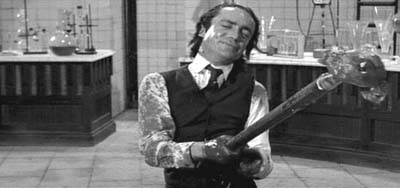
Baron on a stick: Udo Kier meets his demise
Flesh
For Frankenstein cleverly hides its social criticism behind extremes:
extreme violence, extreme bloodshed, extreme sex, extreme 3-D effects,
extremely stupid dialogues, extremely bad acting, extremely silly plot,
extremely well-shot cinematography. Of course, Morrissey did all this on
purpose (at least today he wants to make us believe he did) and uses the
movie to target sexual indulgence. Here everyone is sexually deviant -
from necrophilia, to nymphomania, incest and asexuality. It is up to the
viewer to decide if the movie works on this level - or if it is just a
film that should better be forgotten.
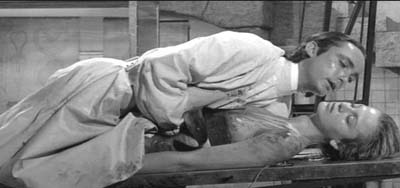
Deviant sexuality , part 2: Udo Kier is making love to Dalila di Lazzaro's
intestines
|
Cast & Crew: |
|
| |
|
|
Baron
Frankenstein |
Udo
Kier |
| Nicholas |
Joe Dallesandro |
| Otto |
Arno Juerging |
| Katrin
Frankenstein |
Monique van Vooren |
| Female
Monster |
Dalila Di Lazzaro |
| Male Monster |
Srdjan Zelenovic |
| |
|
| |
|
|
Screenplay |
Tonino Guerra
Pat Hackett
Paul Morrissey |
|
Music |
Claudio Gizzi |
|
Cinematography |
Luigi Kuveiller |
| Producers |
Andrew Braunsberg
Lou Peraino
Carlo Ponti
Andy Warhol |
| Director |
Paul Morrissey
Antonio Margheriti |


© 1999-2005 Andreas Rohrmoser
|

